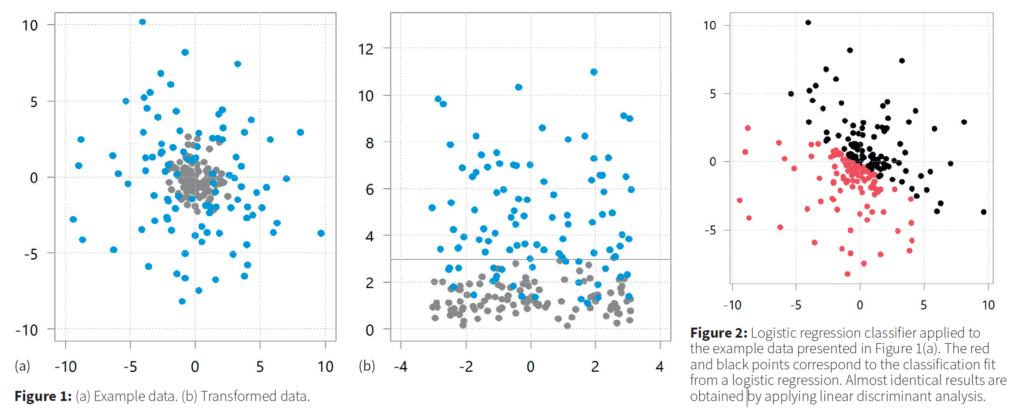Couple of months ago I published a paper in Significance – couple of pages describing the essence of deep learning algorithms, and why they are so popular. I got a few requests for the code which generated the figures in that paper. This weekend I reviewed my code and was content to see that I used a pseudorandom numbers, with a seed (as oppose to completely random numbers; without a seed). So now the figures are exactly reproducible. The actual code to produce the figures, and the figures themselves (e.g. for teaching purposes) are provided below.
|
1 2 3 4 5 6 7 8 9 10 11 12 13 14 15 16 17 18 19 20 21 22 23 24 25 26 27 28 29 30 31 |
library(MASS) library(pracma) set.seed(1212) nn <- 100 tmpp <- mvrnorm(n = nn, mu=c(0,0), Sigma=matrix(c(1,0,0,1), nrow=2, ncol= 2), tol = 1e-6, empirical = FALSE, EISPACK = FALSE) tmpp2 <- mvrnorm(n = nn, mu=c(0,0), Sigma=matrix(c(15,0,0,15), nrow=2, ncol= 2), tol = 1e-6, empirical = FALSE, EISPACK = FALSE) plot(tmpp[,1], tmpp[,2], xlim= c(-10,10), ylim= c(-10,10) , pch= 19, ylab="") points(tmpp2[,1], tmpp2[,2], xlim= c(-10,10), ylim= c(-10,10) , col= 4, pch= 19) grid() tmp4 <- tmp3 <- matrix(nrow= nn, ncol= 2) for (i in 1:nn){ tmp3[i,] <- cart2pol(c(tmpp[i,])) tmp4[i,] <- cart2pol(c(tmpp2[i,])) } plot(tmp3[,1], tmp3[,2], xlim= c(-4,4), ylim= c(0,13), pch= 19, ylab="") points(tmp4[,1], tmp4[,2], col= 4, pch= 19) abline(h= 3) grid() x <- rbind(tmpp,tmpp2) y <- c(rep(0, NROW(tmpp)), rep(1, NROW(tmpp2))) lm0 <- glm(y~x,family = binomial) plot(x, col= (round(lm0$fit)+9), pch=19, ylab="") grid() |
Reference: What’s the big idea? Deep learning algorithms.










Thanks for sharing this! As a note to other readers who might get misled by the usage of the term “pseudorandom” in this article: It’s not the absence of manually setting a seed that defines whether numbers are truly random or pseudorandom but whether the numbers are computationally deterministic. Base R always produces pseudorandom numbers – if one doesn’t manually set a seed, R will automatically generate one. See
?base::Random: “Initially, there is no seed; a new one is created from the current time and the process ID when one is required.” Setting a seed manually makes the pseudorandom numbers *reproducible*, which is great. True random numbers can be obtained e.g. by using the package {random} which obtains them from RANDOM.ORG and thus from atmospheric noise.